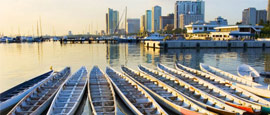Getting around Manila
Public transport in Manila is a mix of light rail, buses, jeepneys and taxis.
Manila’s light rail system presently operates three lines. Metro Rail (tel: +63 2 929 5347; http://dotcmrt3.gov.ph) runs the MRT3 (Yellow Line), which shadows the Epifanio de los Santos Avenue (EDSA) from North Avenue to Taft Avenue accessing Makati and Ortigas. The Light Rail Transit Authority (tel: +63 2 853 0041; www.lrta.gov.ph) operates two lines: LRT1 runs north-south between Monumento and Baclaran; LRT2 flows east to west from Santolan to Recto. Lead coaches are usually reserved for women and senior citizens.
Payment is made by a reloadable contactless smartcard, Beep (http://www.beeptopay.com). The card can also be used to make payments in some convenience stores.
Jeepneys are highly decorative long-wheelbase transporters modelled on US Jeeps. They ply set routes all over Manila. Simply locate the destination map painted on the cab, hail and jump onboard. Call out your destination to the driver and pay a fixed inexpensive fee.
Manila is served by a plethora of private bus companies. Cost varies depending on destination and whether the bus is air-conditioned - tickets are available from kiosks, stations and some shops. There are no bus schedules but EDSA has buses available round the clock.
The Pasig River Ferry Service makes 14 stops along the River Pasig, taking approximately 90 minutes from Plaza Mexico terminus in Metropolitan Manila to San Joaquin near Taguig. Sights include Malacañang Palace.
Grab is a ride-hailing app operating all over Southeast Asia (https://www.grab.com/ph), and Uber is also available. City taxis have flag-down fees and thereafter drivers should use meters. Established taxi operators include Avis (tel: +63 2 831 2701), 24-7 (tel: +63 2 642 3525) and Basic (tel: +63 2 352 7777). Tipping is discretionary but expected. FX Taxis are larger (usually) Toyota utility vehicles that pick up multiple passengers along set routes.
Driving in Manila is not for the faint-hearted, particularly during rush hour on major roads such as EDSA. Traffic darts across lanes with little warning while excessive horn-honking and tailgating is de rigueur.
Road signs are not always obvious and you should expect serious traffic jams. Manila operates a traffic volume reduction program prohibiting vehicles ending in predetermined licence plate numbers from driving for one specific day per week. Those who disobey risk licence confiscation and a fine.
The minimum age for car hire in Manila is between 21 and 25 years old, depending on the company. Foreigners must show passport ID and a valid national driving licence or International Driving Permit.
Major providers include Avis (tel: +63 2 462 2881; www.avis.com.ph) and Budget (www.budget.com). Local company JB Rent-A-Car (tel: +63 2 742 9853; www.jbrentacar.com) offers competitive deals.
Do you have any Feedback about this page?
© 2025 Columbus Travel Media Ltd. All rights reserved. No part of this site may be reproduced without our written permission, click here for information on Columbus Content Solutions.




 You know where
You know where